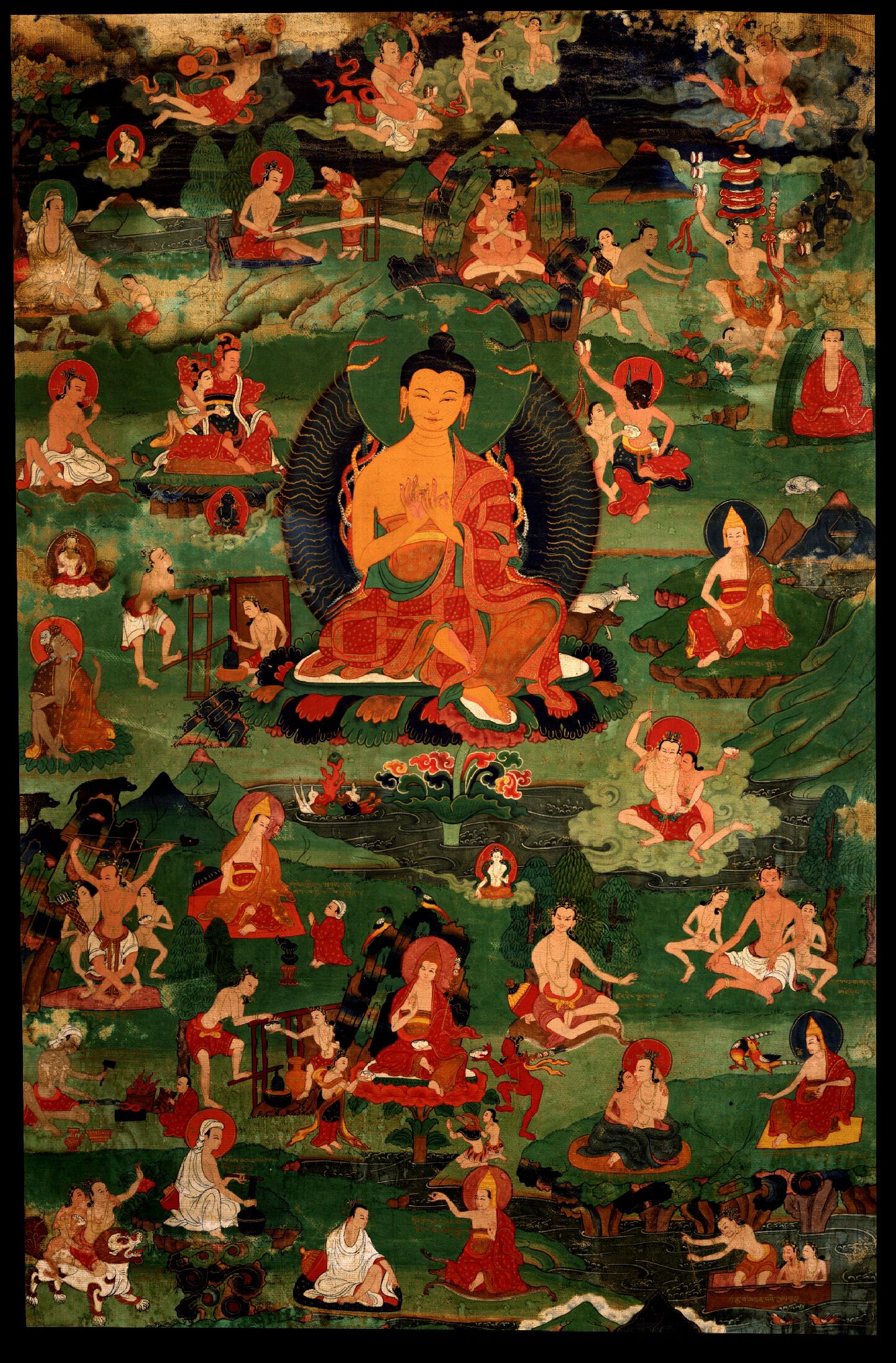|
Four Dharmadhātu
The Four Dharmadhatu () is a philosophical concept propagated by Master Dushun (Chinese: 杜順; 557-640 CE), the founder of the Huayan school. It builds upon and is a variant of the Dharmadhatu doctrine. The Four Dharmadhatu The Four Dharmadhatu were outlined in Dushun's treatise, the title of which has been rendered into English as 'On the Meditation of Dharmadhātu'. The Four Dharmadhatu are: *The Dharmadhātu of ''Shi'' (). ''Shi'' holds the semantic field "matter", "phenomenon", "event". It may be understood as the "realm" (Sanskrit: dhātu) of all matters and phenomena. *The Dharmadhātu of ''Li'' (). ''Li'' holds the semantic field: "principle", "law", "noumenon". This realm may be understood as that of principles. It has been referred to as "the realm of the one principle". The "one principle" being qualified as śūnyatā (Sanskrit). *The Dharmadhātu of Non-obstruction of ''Li'' against ''Shi'' (). This realm has been rendered into English as "the realm of non-ob ... [...More Info...] [...Related Items...] OR: [Wikipedia] [Google] [Baidu] |
Dushun
Dushun ( zh, c=杜順, p=Dùshùn, w=Tu-shun) (557–640) was the First Patriarch of the Huayan School of Chinese Buddhism, which has the Indian Avatamsaka Sutra as its central scripture. Biography Dushun was born in present-day Shaanxi province. He ordained at the age of seventeen and became a student of a monk named Weichen, from whom he learned meditation at Yinsheng temple. Dushun later retired to Zhixiang temple, a monastery in the Zhongnan mountains in the south of Shaanxi. There, Dushun began an in-depth study of the Avataṃsaka Sūtra. The second patriarch, Zhiyan (602-668 CE), studied under Dushun at Zhixiang temple and became recognized as his formal successor.Buswell, Robert E; Lopez, Donald S. ''The Princeton Dictionary of Buddhism,'' p. 275. Princeton University Press, Nov 24, 2013. Dushun was also a devotee of Amitabha and Manjusri, and promoted their worship among the laity. Works Around fourteen works have been ascribed to Dushun throughout history; however ... [...More Info...] [...Related Items...] OR: [Wikipedia] [Google] [Baidu] |
Huayan
The Huayan school of Buddhism (, Wade–Giles: ''Hua-Yen,'' "Flower Garland," from the Sanskrit "''Avataṃsaka''") is a Mahayana Buddhist tradition that developed in China during the Tang dynasty (618-907).Yü, Chün-fang (2020). ''Chinese Buddhism: A Thematic History'', p. 160. University of Hawaii Press. The Huayan worldview is based primarily on the '' Buddhāvataṃsaka Sūtra'' ( zh, t=華嚴經, p=Huáyán jīng, ''Flower Garland Sutra'') as well as on the works of Huayan patriarchs, like Zhiyan (602–668), Fazang (643–712), Chengguan (738–839), Zongmi (780–841) and Li Tongxuan (635–730). Another common name for this tradition is the Xianshou school (''Xianshou'' being another name for patriarch Fazang).Hammerstrom, Erik J. (2020). ''The Huayan University network: the teaching and practice of Avataṃsaka Buddhism in twentieth-century China'', chapter 1. Columbia University Press. The Huayan School is known as Hwaeom in Korea, Kegon in Japan and Hoa Nghi ... [...More Info...] [...Related Items...] OR: [Wikipedia] [Google] [Baidu] |
Dharmadhatu
Dharmadhatu (; ; ) is the 'dimension', 'realm' or 'sphere' (dhātu) of the Dharma or Absolute Reality. Entire Dharmadhatu was filled with an infinite number of buddha-lands (Sanskrit: buddhakṣetra) with ineffable number of Buddhas. This realm is beyond of everything, and it is visible only to Buddhas and all other Bodhisattvas in existence. Definition In Mahayana Buddhism, dharmadhatu means "realm of all phenomena", "realm of all things" (the entire universe with all visible and invisible things) or "realm of eternal truth". It is referred to by several analogous terms from Mahayana Buddhist philosophy, such as ''tathātā'' (reality "as-it-is"), ''śūnyatā'' (emptiness), '' pratitya-samutpada'' (dependent co-arising) and eternal Buddha. It is the "deepest nature, or essence". Dharmadhatu is the purified mind in its natural state, free of obscurations. It is the essence-quality or primal nature of mind, the fundamental ground of consciousness of the trikaya, which is acc ... [...More Info...] [...Related Items...] OR: [Wikipedia] [Google] [Baidu] |
Semantic Field
In linguistics, a semantic field is a related set of words grouped semantically (by meaning) that refers to a specific subject.Howard Jackson, Etienne Zé Amvela, ''Words, Meaning, and Vocabulary'', Continuum, 2000, p14. The term is also used in anthropology,Ingold, Tim (1996). ''Key debates in anthropology''. Routledge. , . Source(accessed: Sunday May 2, 2010), p.127 computational semiotics, and technical exegesis. Definition and usage Brinton (2000: p. 112) defines "semantic field" or "semantic domain" and relates the linguistic concept to hyponymy: Related to the concept of hyponymy, but more loosely defined, is the notion of a semantic field or domain. A semantic field denotes a segment of reality symbolized by a set of related words. The words in a semantic field share a common semantic property. A general and intuitive description is that words in a semantic field are not necessarily synonymous, but are all used to talk about the same general phenomenon.Adrian ... [...More Info...] [...Related Items...] OR: [Wikipedia] [Google] [Baidu] |
Noumenon
In philosophy, a noumenon (, ; from ; : noumena) is knowledge posited as an Object (philosophy), object that exists independently of human sense. The term ''noumenon'' is generally used in contrast with, or in relation to, the term ''Phenomena (philosophy), phenomenon'', which refers to any Object (philosophy), object of the senses. Immanuel Kant first developed the notion of the noumenon as part of his transcendental idealism, suggesting that while we know the noumenal world to exist because human sensibility is merely receptive, it is not itself sensible and must therefore remain otherwise Epistemology, unknowable to us. In Kantianism, Kantian philosophy, the noumenon is often associated with the unknowable "thing-in-itself" (). However, the nature of the relationship between the two is not made explicit in Kant's work, and remains a subject of debate among Kant scholars as a result. Etymology The Ancient Greek, Greek word (plural ) is the Ancient Greek grammar#Participles, ... [...More Info...] [...Related Items...] OR: [Wikipedia] [Google] [Baidu] |
śūnyatā
''Śūnyatā'' ( ; ; ), translated most often as "emptiness", " vacuity", and sometimes "voidness", or "nothingness" is an Indian philosophical concept. In Buddhism, Jainism, Hinduism, and other Indian philosophical traditions, the concept has multiple meanings depending on its doctrinal context. It is either an ontological feature of reality, a meditative state, or a phenomenological analysis of experience. In Theravāda Buddhism, ' often refers to the non-self (Pāli: ', Sanskrit: ') nature of the five aggregates of experience and the six sense spheres. ' is also often used to refer to a meditative state or experience. In Mahāyāna Buddhism, ' refers to the tenet that "all things are empty of intrinsic existence and nature ('' svabhava'')", but may also refer to the Buddha-nature teachings and primordial or empty awareness, as in Dzogchen, Shentong, or Chan. Etymology ''Śūnyatā'' is usually translated as "devoidness", "emptiness", "hollow", "hollowness", "v ... [...More Info...] [...Related Items...] OR: [Wikipedia] [Google] [Baidu] |
Eight Consciousnesses
The Eight Consciousnesses (Skt. ''aṣṭa vijñānakāyāḥ'') are a classification developed in the tradition of the Yogacara, Yogācāra school of Mahayana Buddhism. They enumerate the five sense consciousnesses, supplemented by the mental consciousness (''manovijñāna''), the defiled mental consciousness (''kliṣṭamanovijñāna''), and finally the fundamental store-house consciousness (''ālāyavijñāna''), which is the basis of the other seven.Waldron, William S. The Buddhist Unconscious: The Alaya-vijñana in the context of Indian Buddhist Thought. Routledge Critical Studies in Buddhism, 2003, page 97 This eighth consciousness is said to store the impressions (''vasanas, vāsanāḥ'') of previous experiences, which form the seeds (''bīja'') of future karma in this life and in the next after Rebirth (Buddhism), rebirth. Eightfold network of primary consciousnesses All surviving schools of Buddhist thought accept – "in common" – the existen ... [...More Info...] [...Related Items...] OR: [Wikipedia] [Google] [Baidu] |
Five Wisdoms
The Five Wisdoms are five kinds of wisdoms which appear when the mind is purified of the five disturbing emotions and the natural mind appears.Lone Hansen (Shenphen Chödron), ''The Five Wisdoms'' All of those five wisdoms are represented by one of the five buddha-families. The last four these five are also called the "four wisdoms" (四智). Meaning and translations ''Pañca-jñāna'' is rendered in English as: "five wisdoms," "five awarenesses," or "five pristine cognitions."Interpretations The Five Wisdoms are: # ''Tathatā-jñāna'', the wisdom of[...More Info...] [...Related Items...] OR: [Wikipedia] [Google] [Baidu] |
Two Truths Doctrine
The Buddhism, Buddhist doctrine of the two truths (Sanskrit: '','' ) differentiates between two levels of ''satya'' (Sanskrit; Pāli: ''sacca''; meaning "truth" or "reality") in the teaching of Gautama Buddha, Śākyamuni Buddha: the "conventional" or "provisional" (''saṁvṛti'') truth, and the "absolute" or "ultimate" (''paramārtha'') truth. The exact meaning varies between the various Schools of Buddhism, Buddhist schools and Southern, Eastern and Northern Buddhism, traditions. The best known interpretation is from the Madhyamaka, Mādhyamaka school of Mahayana, Mahāyāna Buddhism, whose founder was the 3rd-century History of Buddhism in India, Indian Buddhist monk and philosopher Nagarjuna, Nāgārjuna. For Nāgārjuna, the two truths are ''epistemological truths''. The phenomenal world is accorded a provisional existence. The character of the phenomenal world is declared to be neither real nor unreal, but logically indeterminable. Ultimately, Śūnyatā, all phenomena are ... [...More Info...] [...Related Items...] OR: [Wikipedia] [Google] [Baidu] |
Yogacara
Yogachara (, IAST: ') is an influential tradition of Buddhist philosophy and psychology emphasizing the study of cognition, perception, and consciousness through the interior lens of meditation, as well as philosophical reasoning (hetuvidyā). Yogachara was one of the two most influential traditions of Mahayana, Mahayana Buddhism in India, along with Madhyamaka. The compound ''Yogācāra'' literally means "practice of yoga", or "one whose practice is yoga", hence the name of the school is literally "the school of the yogins". Yogācāra was also variously termed ''Vijñānavāda'' (the doctrine of consciousness), ''Vijñaptivāda'' (the doctrine of ideas or percepts) or ''Vijñaptimātratā-vāda'' (the doctrine of 'mere representation'), which is also the name given to its major theory of mind which seeks to deconstruct how we perceive the world. There are several interpretations of this main theory: various forms of Idealism, as well as a Phenomenology (philosophy), phenomen ... [...More Info...] [...Related Items...] OR: [Wikipedia] [Google] [Baidu] |



